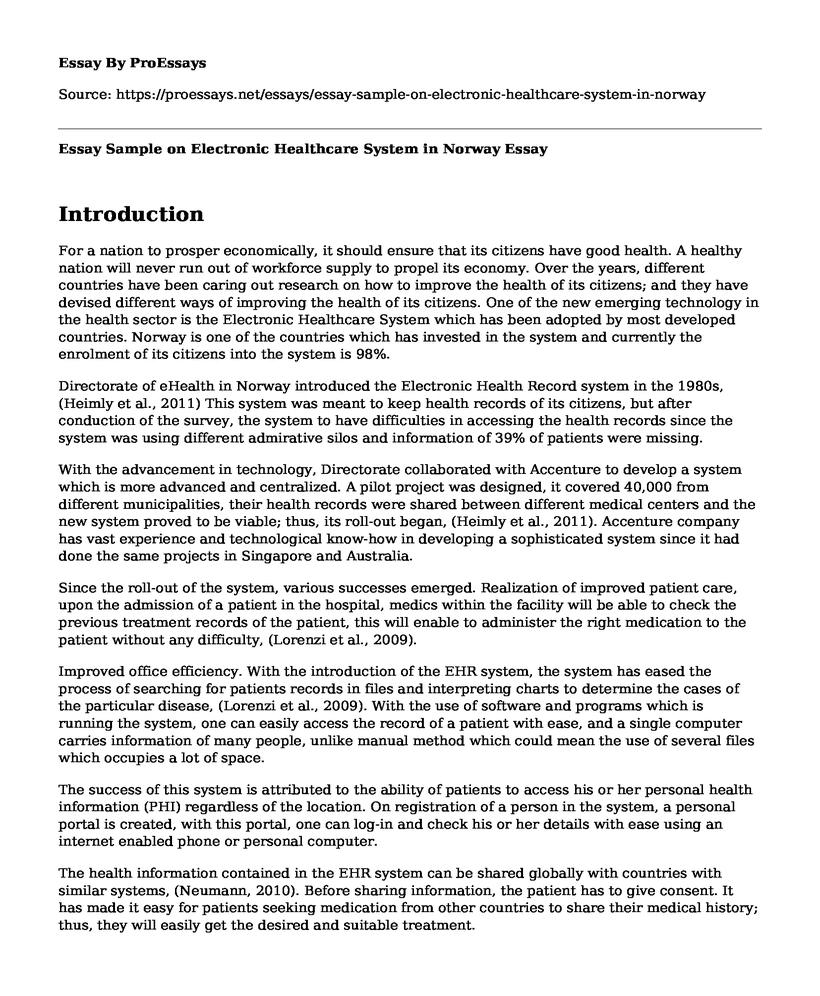Introduction
For a nation to prosper economically, it should ensure that its citizens have good health. A healthy nation will never run out of workforce supply to propel its economy. Over the years, different countries have been caring out research on how to improve the health of its citizens; and they have devised different ways of improving the health of its citizens. One of the new emerging technology in the health sector is the Electronic Healthcare System which has been adopted by most developed countries. Norway is one of the countries which has invested in the system and currently the enrolment of its citizens into the system is 98%.
Directorate of eHealth in Norway introduced the Electronic Health Record system in the 1980s, (Heimly et al., 2011) This system was meant to keep health records of its citizens, but after conduction of the survey, the system to have difficulties in accessing the health records since the system was using different admirative silos and information of 39% of patients were missing.
With the advancement in technology, Directorate collaborated with Accenture to develop a system which is more advanced and centralized. A pilot project was designed, it covered 40,000 from different municipalities, their health records were shared between different medical centers and the new system proved to be viable; thus, its roll-out began, (Heimly et al., 2011). Accenture company has vast experience and technological know-how in developing a sophisticated system since it had done the same projects in Singapore and Australia.
Since the roll-out of the system, various successes emerged. Realization of improved patient care, upon the admission of a patient in the hospital, medics within the facility will be able to check the previous treatment records of the patient, this will enable to administer the right medication to the patient without any difficulty, (Lorenzi et al., 2009).
Improved office efficiency. With the introduction of the EHR system, the system has eased the process of searching for patients records in files and interpreting charts to determine the cases of the particular disease, (Lorenzi et al., 2009). With the use of software and programs which is running the system, one can easily access the record of a patient with ease, and a single computer carries information of many people, unlike manual method which could mean the use of several files which occupies a lot of space.
The success of this system is attributed to the ability of patients to access his or her personal health information (PHI) regardless of the location. On registration of a person in the system, a personal portal is created, with this portal, one can log-in and check his or her details with ease using an internet enabled phone or personal computer.
The health information contained in the EHR system can be shared globally with countries with similar systems, (Neumann, 2010). Before sharing information, the patient has to give consent. It has made it easy for patients seeking medication from other countries to share their medical history; thus, they will easily get the desired and suitable treatment.
With the advancement in technology, the world has become a global village. Electronic Health Record system has made it possible to get the whole information of the medical history of a patient even if the patient is in another country.
Conclusion
In conclusion, the EHR system has eased access to the medical history of a person; other countries should advocate this system because it has more pros as compared to cons. One of its cons is the initial cost of installing the system, but once the system is operational, it will serve good to the citizens by easing access to medical history; hence one can manage his health.
References
Lorenzi, N. M., Kouroubali, A., Detmer, D. E., & Bloomrosen, M. (2009). How to successfully select and implement electronic health records (EHR) in small ambulatory practice settings. BMC medical informatics and decision making, 9(1), 15.
Neumann, L. (2010). Comparative Domestic and International EHR Adoption. National Electronic Health Records Summit.
Heimly, V., Grimsmo, A., & Faxvaag, A. (2011). Diffusion of Electronic Health Records and electronic communication in Norway. Applied clinical informatics, 2(03), 355-364.
Cite this page
Essay Sample on Electronic Healthcare System in Norway. (2022, Nov 17). Retrieved from https://proessays.net/essays/essay-sample-on-electronic-healthcare-system-in-norway
If you are the original author of this essay and no longer wish to have it published on the ProEssays website, please click below to request its removal:
- Paper Example on Environmental Health
- Essay Sample on Coaching International Workers Who Experience Burnout and Stress Problems
- Criteria for the Diagnosis of Infection Paper Example
- Essay Example on Unveiling Public Health: Exploring the Role of Epidemiology
- Essay Sample on Covid-19: Alarming Global Spread & Healthcare Industry at Risk
- Ideal Diet for Diabetics: How Sampling Can Help - Research Paper
- Essay Example on Benner's Competency Assessment







